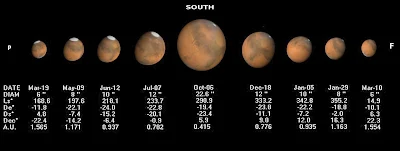 |
| 2004 |
Sometimes waking up a bit earlier when the sunrise is coming later leads you to some interesting things.
It was quite humid in Northern Virginia on the morning of 25 August 2020, but the skies were surprisingly clear. I stepped outside at about 0500 local time, coffee cup in hand. Venus was blazing in the east. Then I saw this big very bright red thing high in the southern sky. It seemed almost too bright and too high in the sky to be Mars. But a quick check with Stellarium showed that it was in fact the Red Planet. I pulled out my six inch Dobsonian reflector telescope and soon had Mars in the eyepiece.
For the first time in many years I could see surface features: It is springtime in the southern hemisphere of Mars, but the Southern Polar Cap (which recedes in the summer) was still very prominent (in my eyepiece it was near the top, as in the GIF above) . I could also see an albedo (dark on light) feature below the icecap.
I went out again on the morning of 26 August 2020. Again the Southern Polar Cap was very visible. Below it, near the center of the disc, I could make out a large albedo feature. I am pretty sure that is Mare Erythraeum.
Above is what Stellarium presented as Mars as viewed from Earth this morning. The Southern Polar Cap is much more prominent in my telescope (you can see it in the upper right in the image above). The large dark thing near the center of the disc is Erythraeum. In the Stellarium image you can see the enormous Vallis Marinaris canyon shooting off to the lower right (sadly I could not see this in my telescope).
The GIF at the top of this post gives a much better view than I get with my little six inch telescope. The GIF gives a good idea of what the albedo features and the ice cap look like.
This was a great time for me to see these things. I'm almost done with the second book in Kim Stanley Robinson's Mars Trilogy -- much of the story takes place in sanctuaries carved under the Southern ice cap, and in Hellas (which Robinson's colonists are filling with water). During the 2018 Earth-Mars opposition a big dust storm made it impossible for me to see anything on Mars; a similar storm takes place during book one of Robinson's Trilogy. And right now the Perseverance rover is on its way to Mars.
This 2020 opposition will be the best one until 2033. So don't miss it.

Here is a good article on observing Mars during the current opposition:
https://www.skyatnightmagazine.com/advice/skills/how-to-observe-mars/
Here are technical details on the 2020 opposition:
http://www.alpo-astronomy.org/jbeish/2020_MARS.htm
To see what side of Mars is facing us at any time, use Sky and Telescope's Mars Profiler:
https://skyandtelescope.org/observing/interactive-sky-watching-tools/mars-which-side-is-visible/#
Here is a very informative video about the 2020 opposition:
And remember: The Elser-Mathes Cup has still not been won.














